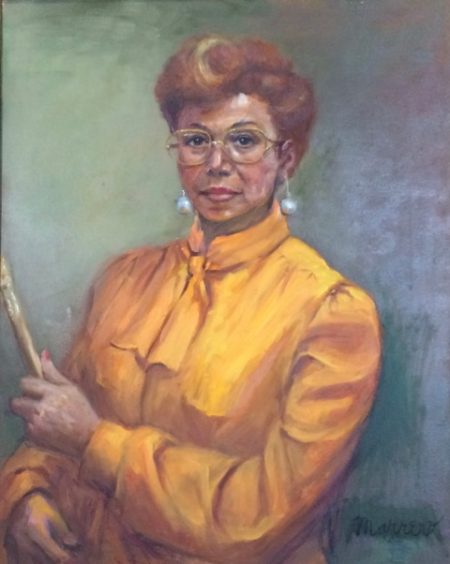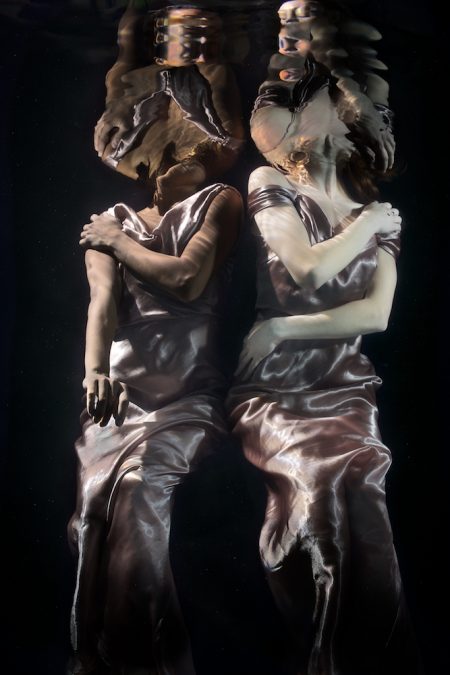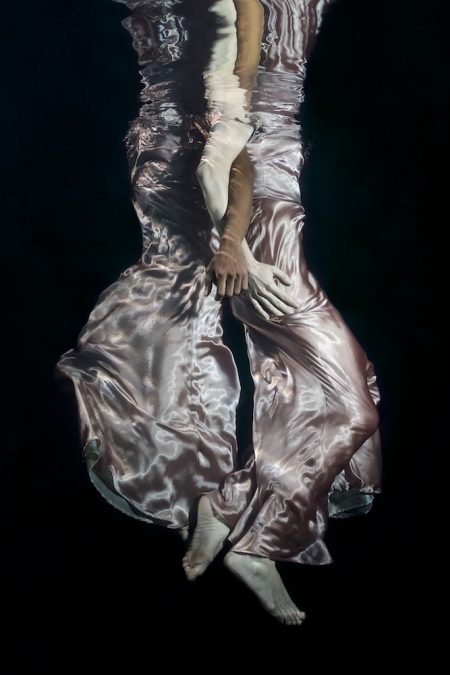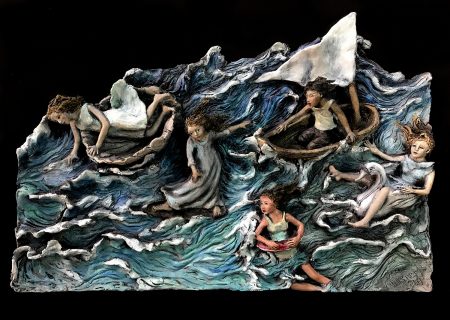March is nationally celebrated as Women’s History Month.
In keeping with its stated mission of eliminating racism and empowering women, the Greater Cincinnati YWCA has mounted an exhibition encompassing the expressive works of nine local women who examine their own attitudes of identity, entitlement and personal experiences of victimization. The exhibiting artists are: Yvonne van Eijden, Velma Morris, Mary Barr Rhodes, Cynthia Lockhart, Tina Gutierrez, Edith Susarret Marrero, Gloria McConnaghy, Gabrielle McFarland and Jan Wiesner.
Ascending the stairs on the Walnut St. location, a large open canvas by Yvonne van Eijden is the first work encountered. What is perhaps a self portrait in limited values is overwritten with the stenciled 2 line phrase: “A country with a soul, a country with redemptions…” . These opening lines of a poem by van Eijden are elaborated on a note attached to the canvas surface.
Van Eijden exhibits additional paintings more formulaic in imagery. Awash with light, androidal figures emerge upward from abysses of dark warm washes. Snatches of obscure script emphasize silenced voices and isolation. In “Second Conversations, Pt 2”, a longer script is barely detectable as hairless figures roll away from view in the dark recesses, solitary in their existences.
Multiple portraits are presented by Puerto Rican painter Edith Susarret Marrero. A self-taught artist raised in Spanish Harlem, Marrero earned her admission and a Bachelor of Fine Arts at Pratt Institute of Technology. Marrero’s multiple works feature portraits of women and the relationships that support them. Titled “Earth Mother”, “Friends” and “Mother and Daughter” among others, these paintings celebrate the embrace and support of friends and family as well as alliances with Mother Earth. Most impressive to this writer is her “Self Portrait” in the main hall. Jacketed in bold color and grasping her brush, the artist confronts the viewer with a larger than life confidence in her life and career choices. Marrero can be found today, a practicing member of the Cincinnati Art Club, continuing her concentration on her drawing and pastel work.
Velma Morris shows a large format acrylic entitled “On the Bus”, in which colorfully rendered bus interior powers forward in a blinding light. Numerous adults and children occupy the available seating. In contrast a solitary figure stands in the aisle, awaiting the anticipated stop. The painting may be sourced from the painter’s personal experience, vaguely revisiting the Rosa Parks incident while seated on the bus herself.
Morris also shows another acrylic mixed media abstract with directional arrows, wheels and markers that relate to the traffic sense of the first work.
Mary Barr Rhodes shows two works. “On the Rocks” is a 32″ x60″ vertical that vaguely alludes to a Venus as an underlying gesture. A cascade of gold and silver washes are studded with clear chunks and sprays of periodic textures. Another work is a 30″ square canvas with swirling mixed media in red and gold. These works amount to little more than decorative distraction.
The real meat of the exhibit lies in the photographic visions of Tina Gutierrez and the sculptural friezes of Jan Wiesner. The work of these two artists contribute uniquely and significantly to the show in theme and content.
Gutierrez shows “Rare Species 1”, a photo print on aluminum of a single floating figurative in a suspended gesture. The enveloping textured wrap in brilliant vermillion abstractly obscures the female figure while transforming it into a bursting life force in midair.
In another large photographic print, “The Weavers”, Gutierrez works with two women, brown and white, dressed in identical silk attire. Aligned at the shoulder with mirrored gestures, they descend in a watery world where their blurred facial features, though abstracted in aquatic refraction, seem to commence conversation. The muted palette of silvery tones and neutrals is exceptionally beautiful. The resulting image is at once eloquent, equalizing on message and lyrically designed.
Jan Wiesner has turned to visual parables to investigate the woman message.
She shows several sculptural friezes that relate as a progressive message or journey, akin to a typical ‘way of the cross’ found in Catholic churches or convent gardens. Wiesner’s vignettes function similarly as a series of episodic junctures for meditative observations.
“To Each Their Own Way in Navigating the Turbulent Waters of Life” depicts several women in a turbulent sea, each with their own flotation devices: a tube tire, a giant shell, a hilarious inflated swan and the single plank of a primitive surf board. These flimsy devices contrast with a single-masted sailed boat. While her simple wooden skiff provides a better predictive of safety and success than her companions’, the woman grips the sides in white-knuckled terror, as she freefalls through the giant waves after the others.
Another vignette is entitled “Stand UP!”
A half dozen equi-sized women of multiple ethnicities stand shoulder to shoulder across the opening of an apse-like arch. All are dressed in long white gowns. Black and golden tresses of hair, a woman’s crowning glory, are twined together, vining upward supporting the feet of two women, one black and one white who are linked arm in arm as they stand back to back on the shoulders of the group below. The verticality of this frieze is amplified by the intricate fruited vining on the vaulted opening which frames the action.
This series would be more powerful if exhibited as a group in a linear logic, from strife ridden journey to the final frieze, black and white together, uplifted in a triumphal archway.
While this exhibit decries the societal problems of disenfranchisement and reverberates with the effects of detrimental repression, there is also hope and the strength found in the bonds of sisterhood. Thought-provoking artworks stimulate conversations about racial constructs and historical dis-empowerment while examining expressions of women artists of all colors, their identities and aspirations.
–Marlene Steele










April 1st, 2019at 2:26 pm(#)
I had the pleasure of seeing this amazing exhibition last week. Honestly, I would of stayed all day if I could. The entire exhibition was curated beautifully and with so much meaning. I especially loved Mary Barr Rhodes large mixed media that included a very profound message that completely resonated with me. It said “There is no limit to what we as women can accomplish” by Michelle Obama. Kudos to Mary for summing up the entire show with those impactful words incorporated within her work. They are inspirational to all women and in particular women artists.